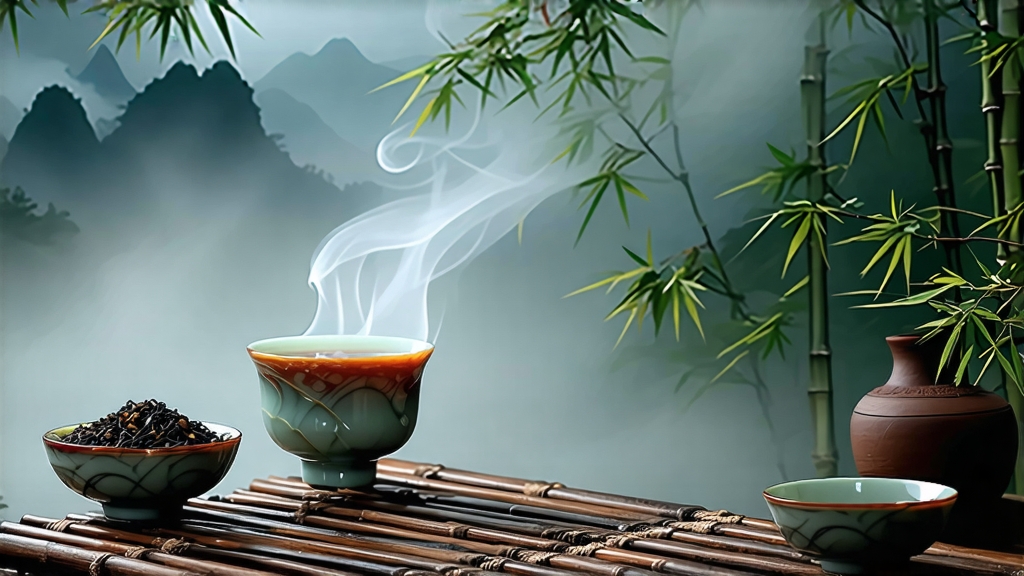
High in the rugged folds of northern Fujian’s Wuyi Mountains, where mist rises off limestone cliffs and every valley carries the scent of pine and camphor, tea makers in the mid-seventeenth century stumbled upon a discovery that would reshape global palates: the world’s first fully oxidized leaf, later christened “black tea” by Europeans, yet still known in China as hong cha—“red tea”—for the beautiful russet color of its infusion. The original style, Lapsang Souchong, remains the most storied and polarizing of all Chinese black teas, prized for its haunting balance of pine smoke, longan sweetness, and mineral depth. To understand it is to taste three and a half centuries of trade, war, migration, and meticulous craft.
History: From Ming-Era Accident to London Drawing Rooms
Legend dates the birth of Lapsang Souchong to 1646, when Qing army units passed through Xingcun village near Tongmu Pass. Farmers, told to vacate, rushed the last of their fresh leaves over smoldering pine fires so the crop would not spoil. The resulting tea—dark, fragrant, stable—arrived months later at Fuzhou port, where Dutch buyers shipped it to Batavia and then Amsterdam. By 1669 the British East India Company had listed “Bohea Souchong” in its ledgers; within two decades smoky Lapsang was steeping in silver strainers from Whitehall to Williamsburg. The name itself encodes geography: “Lap” from the local dialect word for pine (la), “sang” from the village of Sangpan, and “souchong” meaning the small, open-leaf grade plucked after the prized pekoe tips had been taken. Thus a wartime improvisation became the prototype for every black tea that followed—Keemun, Assam, Ceylon—yet none ever replicated that primal campfire note.
Terroir: Why Only Tongmu Tastes Like Tongmu
Authentic Lapsang Souchong can only be produced inside the 565 km² core zone of the Wuyi National Nature Reserve, a UNESCO dual heritage site where elevations range from 600 to 1,400 m, annual rainfall tops 2,200 mm, and daytime fog filters UV light into a soft, even glow. The soil is a stony, slightly acidic laterite rich in potassium and manganese, forcing tea bushes—mostly small-leaf cultivars of Camellia sinensis var. sinensis known as “cai cha” or “vegetable tea”—to send roots deep into fissures of weathered tuff. Night temperatures can drop 15 °C below daytime highs, slowing metabolism and concentrating aromatic precursors. Crucially, the reserve is also home to Masson pine (Pinus massoniana) and Chinese red pine (Pinus tabuliformis); their resinous heartwood supplies the smoking fuel that gives the tea its signature fragrance. Move the same cultivar and recipe even ten kilometers outside the pass and the liquor turns blunt, the smoke acrid, the sweetness flat.
Leaf Grades: From Sublime Buds to Workhorse Broken
Within the Lapsang family three grades dominate export markets. The highest, Tongmu Jinzheng (Golden Needle), uses only the unopened bud and first half-inch leaf picked before Qingming festival; after smoking it appears glossy black with golden tips and brews a crystalline amber liquor reminiscent of dried longan and cacao. The traditional grade, Zhengshan Xiaozhong, mixes bud and two leaves, yielding a darker leaf, deeper smoke, and a malty mid-palate that can stand up to milk and sugar—the style that fueled Victorian breakfast blends. Finally, Wuyi Congou (often mislabeled “Lapsang” abroad) is a larger-leaf, later-season tea lightly smoked or even baked in electric ovens for cost-conscious markets; it lacks the perfume of the mountain original but still carries a whisper of pine and stone fruit.
Craft: The Eight Steps That Trap a Forest in a Leaf
- Plucking: Dawn pickings of 2.5–3 kg tender shoots per worker, delivered to the factory within two hours to prevent compression bruises.
- Withering: Leaves are spread 3 cm deep on bamboo trays set into wooden racks above riverside huts. For 8–10 hours cool, humid air is